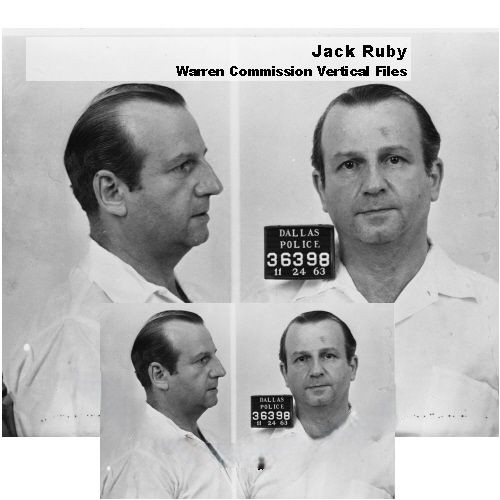
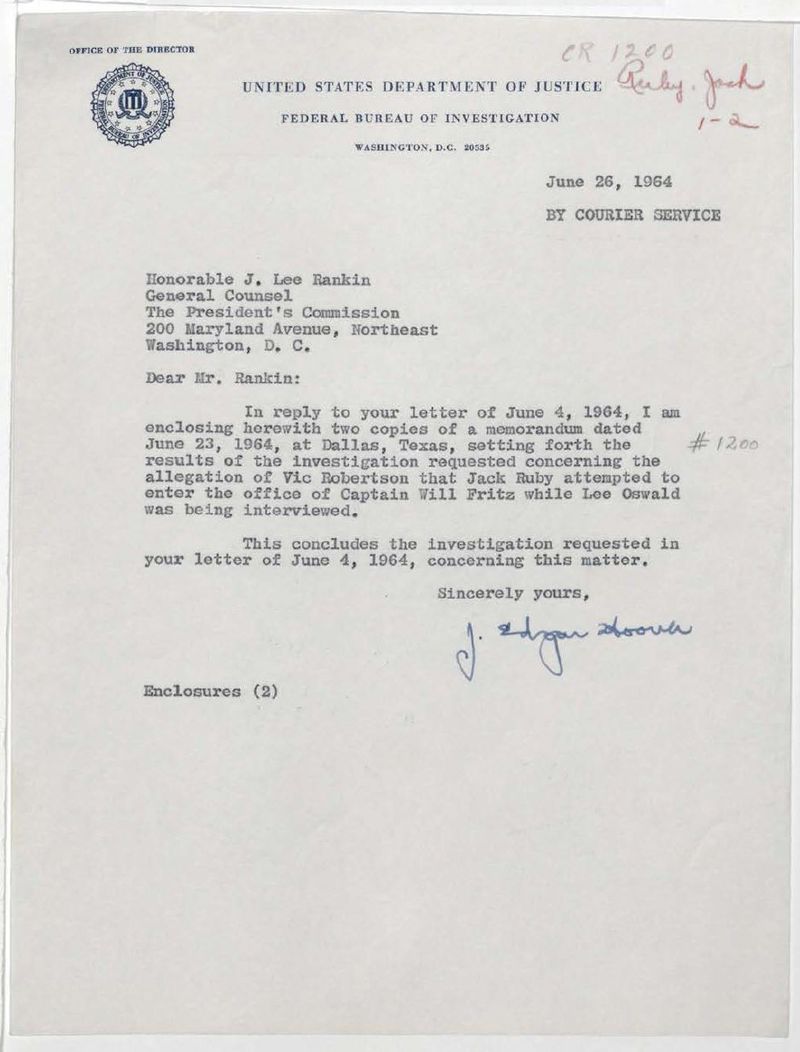

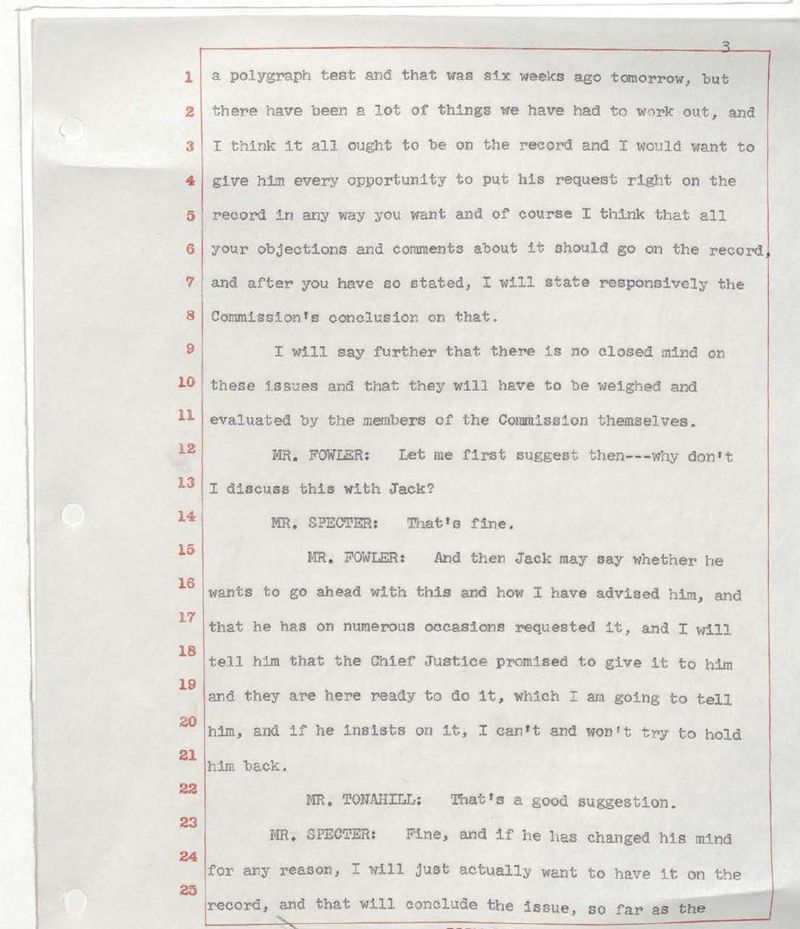
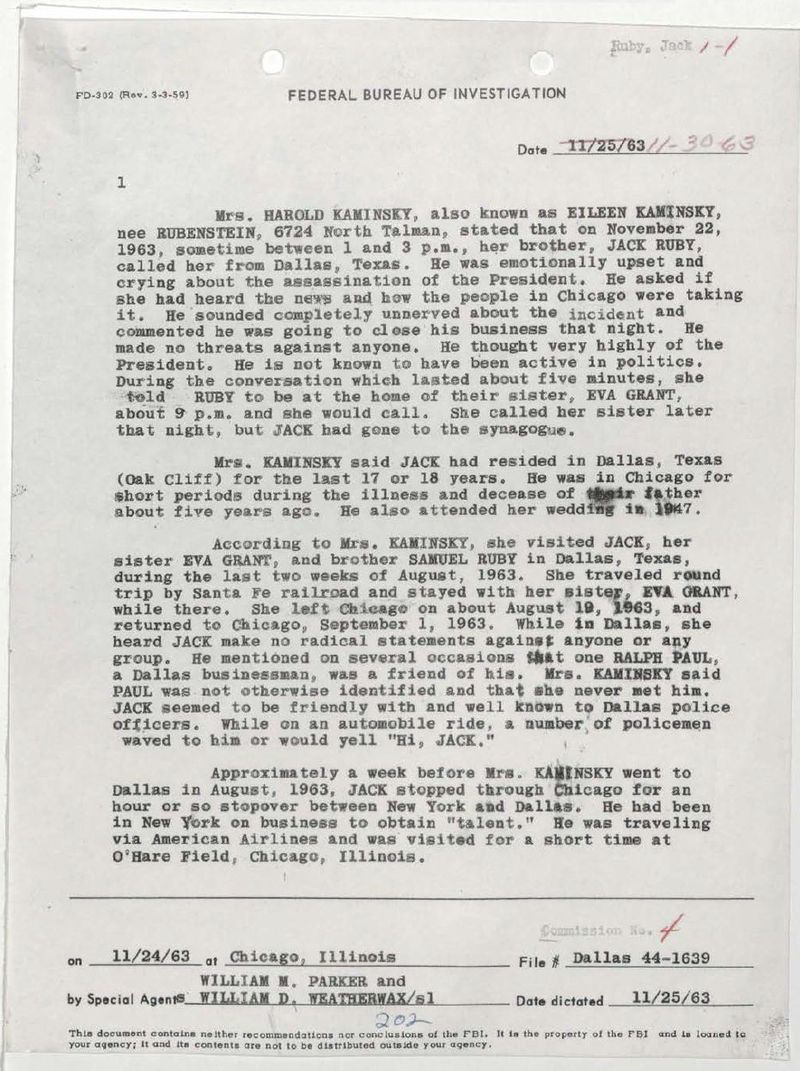
JFK Assassination Jack Ruby Warren Commission Vertical Files
$19.50
Description
The Jack Ruby Timeline
Timeline of Events
- March 25, 1911: Jacob Leon Rubenstein (later Jack Ruby) is born.
- November 22, 1963:President John F. Kennedy is assassinated in Dallas, Texas.
- Dallas Police Department patrolman J.D. Tippit is murdered.
- Lee Harvey Oswald is arrested by the Dallas Police as a suspect in the murder of patrolman Tippit.
- Oswald is later charged with the murders of both President Kennedy and Officer Tippit.
- November 24, 1963:Jack Ruby fatally shoots Lee Harvey Oswald in the basement of the Dallas Police Department headquarters building. Oswald is in police custody at the time.
- November 29, 1963:President Lyndon Johnson issues Executive Order 11130, creating the President’s Commission on the Assassination of President Kennedy, also known as the Warren Commission.
- Unspecified date: A Dallas jury finds Jack Ruby guilty of murdering Lee Harvey Oswald and sentences him to death.
- Unspecified date: Ruby’s conviction and death sentence are overturned, and a new trial is granted.
- January 3, 1967: Jack Ruby dies of a pulmonary embolism at Parkland Hospital in Dallas, Texas.
Cast of Characters
- Jack Ruby (Jacob Leon Rubenstein):
- Born March 25, 1911, died January 3, 1967.
- Nightclub operator in Dallas, Texas, owning the Carousel Club and the Vegas Club.
- Fatally shot Lee Harvey Oswald in police custody.
- Convicted of Oswald’s murder, later granted a new trial.
- Died from a pulmonary embolism while awaiting a new trial.
- Lee Harvey Oswald:
- Arrested by Dallas Police as a suspect in the murder of patrolman J.D. Tippit shortly after President Kennedy’s assassination.
- Charged with the murders of President Kennedy and Patrolman Tippit.
- Fatally shot by Jack Ruby while in police custody.
- John F. Kennedy:
- President of the United States.
- Assassinated in Dallas, Texas, on November 22, 1963.
- Pronounced dead at Parkland Hospital.
- J.D. Tippit:
- Dallas Police Department patrolman.
- Murdered shortly after the assassination of President Kennedy.
- Lyndon B. Johnson:
- President of the United States following Kennedy’s assassination.
- Created the Warren Commission via Executive Order 11130.
- Earl Warren:
- Chief Justice of the United States.
- Chairman of the President’s Commission on the Assassination of President Kennedy (Warren Commission).
- Melvin Belli:
- Mentioned in the Ruby files as connected to “Trial” proceedings. Probably an attorney.
Key Points and Notes:
- The primary focus of the provided documents is on Jack Ruby, as evidenced by the title of the files, the page count, and the subject headings.
- The Warren Commission was established to investigate the assassination of President Kennedy and the subsequent killing of Lee Harvey Oswald.
- The documents include a variety of materials related to Jack Ruby’s life and activities, including his business dealings, relationships, and the events leading up to and following the shooting of Oswald.
- The events all took place within a brief period, from Kennedy’s assassination on November 22, 1963, to Ruby’s death on January 3, 1967.
- The sources reference Federal, State and local agencies such as the FBI, Secret Service, and Department of Defense.
JFK Assassination Jack Ruby Warren Commission Vertical Files
This collection contains 8,982 pages of documents, organized into 65 folders, focused on Jack Ruby. These materials were chosen from the “Key Persons” files of the Warren Commission, which investigated President Kennedy’s assassination.
Jacob Leon Rubenstein, born March 25, 1911, and later known as Jack Ruby, owned two Dallas nightclubs, the Carousel Club and the Vegas Club, in November 1963. On November 22, 1963, Dallas police arrested Lee Harvey Oswald for the murder of Officer J.D. Tippit. Based on information from various law enforcement bodies, Texas officials charged Oswald with the murders of both President Kennedy and Officer Tippit within 12 hours of his arrest.
Two days later, on November 24, 1963, Ruby shot and killed Lee Harvey Oswald while Oswald was being held by police in the basement of the Dallas Police Department. Ruby was convicted of Oswald’s murder by a Dallas jury and initially received a death sentence. However, Ruby successfully appealed his conviction and was granted a retrial. Before the retrial could occur, Ruby, suffering from lung cancer, died of a pulmonary embolism on January 3, 1967, at Parkland Hospital, the same hospital where both Oswald and President Kennedy had previously died. The Commission made copies of documents from its own records to create a focused collection about Jack Ruby. The majority of these documents not originally made by the Commission came from the FBI. Other contributions came from the Secret Service, Department of Defense, Dallas Police Department, and various other government bodies. These files detail all facets of Jack Ruby’s life and actions. The documents include interviews, reports, testimony transcripts, depositions, sworn statements, memos about people’s backgrounds, administrative paperwork, notices, and correspondence.
The folders are categorized by topics such as Ruby’s actions, his response to the assassination, his presence at the police station, how he entered the basement of the police station, his background, his connections, his involvement with labor unions, his alleged racketeering and subversive activities, his friends and family, his association with Oswald, his business and finances, his income tax information, his familiarity with law enforcement, his health and personal history, his military service, his criminal record, his political involvement, his travels, his address book, his mail and telegrams, his personal belongings, his phone calls, his revolver, his possible motive, witness interviews, his arrest and questioning, his trial, his relationship with Melvin Belli, his conviction, and events that followed.
President Johnson established the President’s Commission on the Assassination of President Kennedy through Executive Order 11130 on November 29, 1963. This commission, often called the Warren Commission after its chairman, Chief Justice Earl Warren, was charged with investigating President Kennedy’s assassination in Dallas on November 22, 1963, and the later killing of Lee Harvey Oswald. The commission was also tasked with assessing its findings and reporting its conclusions to the President.
Related products
-
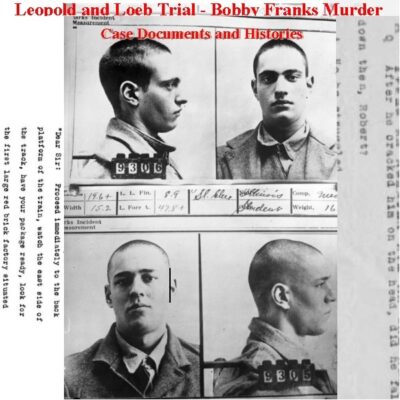
Leopold and Loeb Trial – Bobby Franks Murder Case Documents and Histories
$19.50 Add to Cart -

John F. Kennedy Assassination Dallas Police Department Files
$19.50 Add to Cart -
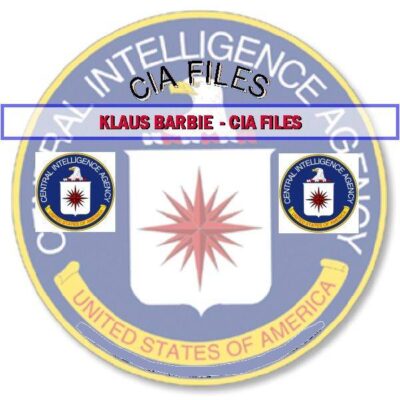
Klaus Barbie CIA Files
$19.50 Add to Cart -

Joseph Valachi FBI Files – Congressional Hearings & Other Historical Material
$19.50 Add to Cart